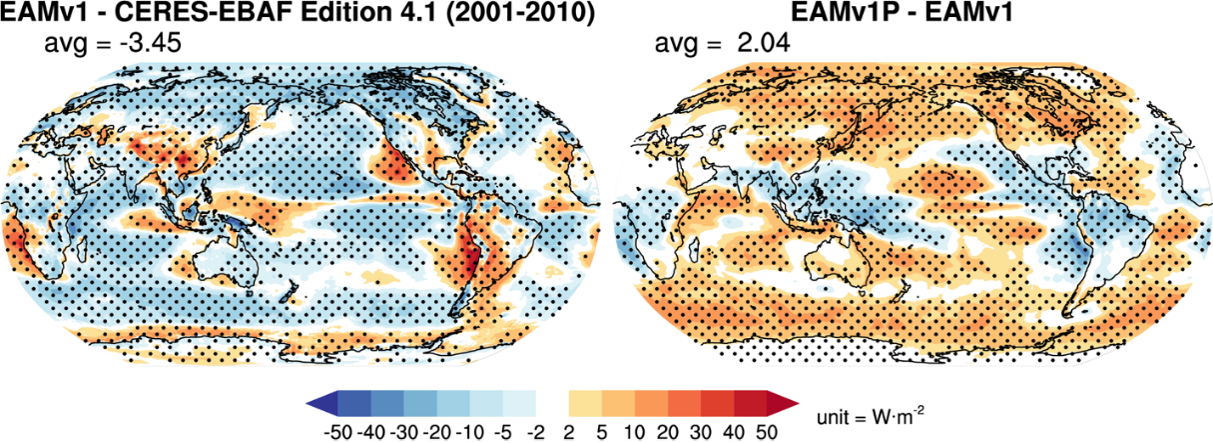Better Calibration Leads to a Significant Improvement in Model Fidelity
The Science
Realistically simulating the Earth’s base state climate, today’s standard climate, remains a major challenge. Model errors and biases can lead to unrealistic climate projections as well as incorrect attributions of the physical processes that govern past and future climate changes. New research (Ma et al., 2022) shows that significantly improved global atmospheric simulation can be achieved using the Energy Exascale Earth System Model (E3SM) Atmosphere Model version 1 (EAMv1). The research objective was to achieve a more realistic representation of the physical processes governing clouds during model calibration by focusing on a subset of skill metrics related to cloud processes rather than the standard dozen or more metrics.
The Impact
Model calibration is a time- and resource- intensive procedure in Earth system modeling. The goal of calibration is to have the model climate agree with observables, while also satisfying energy balance requirements. This new calibration procedure increases model fidelity by addressing the trade-offs that occur when optimizing multiple processes. Better calibrating clouds and subgrid effects also improves other aspects of the climate system, even though they are not the tuning targets. Furthermore, this approach significantly reduces the sensitivity of clouds, precipitation, and surface temperature to changes in aerosols and reduces cloud feedbacks. These results suggest that the recalibrated model could potentially lead to improved predictions of the evolution of the climate system.
Summary
Traditional model calibration requires many simulations followed by a scientific assessment to optimize many aspects of model fidelity. In this study, an integral part of the tuning strategy involves intentional focus on a small subset of skill metrics related to cloud processes. Researchers informed their recalibration of clouds and subgrid effects using scientific understanding of the physical mechanisms underlying cloud processes. This leads to significant improvements in modeling clouds and precipitation climatology, reducing common and longstanding biases across cloud regimes (Fig 1). The improved cloud fidelity in turn reduces biases in other aspects of the climate system. Furthermore, the recalibrated model exhibits weaker sensitivities to aerosol perturbations and surface warming for both clouds and precipitation. The researchers concluded that details about effective radiative forcings and cloud feedback, such as spectral composition and geographical distribution, as well as the fidelity of the unperturbed base climate state are important for realistic predictions of climate evolution.
Publication
- Ma, P.-L., Harrop, B. E., Larson, V. E., Neale, R. B., Gettelman, A., Morrison, H., et al. “Better calibration of cloud parameterizations and subgrid effects increases the fidelity of the E3SM Atmosphere Model version 1.” Geosci. Model Dev., 15(7), 2881-2916, (2022). [DOI: 10.5194/gmd-15-2881-2022]
Funding
- The model tuning work was supported as part of the Energy Exascale Earth System Model (E3SM) project. The analyses of effective radiative forcing and aerosol-cloud interactions were supported as part of the Enabling Aerosol-cloud interactions at GLobal convection-permitting scalES (EAGLES) project. The E3SM and EAGLES projects were sponsored by the U.S. Department of Energy, Office of Science, Office of Biological and Environmental Research, Earth System Model Development program area. The cloud diagnostics and feedback analyses were supported as part of a cloud diagnostics project and Program for Climate Model Diagnosis & Intercomparison (PCMDI), respectively, both sponsored by the U.S. Department of Energy, Office of Science, Office of Biological and Environmental Research, Regional and Global Model Analysis program area. The development and evaluation of gustiness effects over land were part of the Integrated Cloud, Land-Surface, and Aerosol System Study (ICLASS) science focus area, sponsored by the U.S. Department of Energy, Office of Science, Office of Biological and Environmental Research, Atmospheric System Research program.
Contact
- Po-Lun Ma, Pacific Northwest National Laboratory
- Ruby Leung, Pacific Northwest National Laboratory
This article is a part of the E3SM “Floating Points” Newsletter, to read the full Newsletter check:




